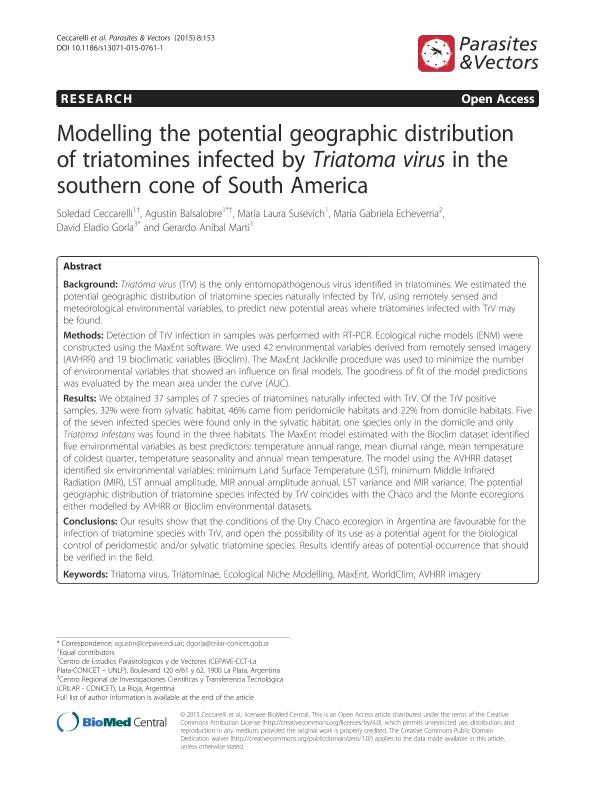Mostrar el registro sencillo del ítem
dc.contributor.author
Ceccarelli, Soledad

dc.contributor.author
Balsalobre, Agustin

dc.contributor.author
Susevich, Maria Laura

dc.contributor.author
Echeverria, Maria Gabriela

dc.contributor.author
Gorla, David Eladio

dc.contributor.author
Marti, Gerardo Anibal

dc.date.available
2017-01-02T17:50:19Z
dc.date.issued
2015-03
dc.identifier.citation
Ceccarelli, Soledad; Balsalobre, Agustin; Susevich, Maria Laura; Echeverria, Maria Gabriela; Gorla, David Eladio; et al.; Modelling the potential geographic distribution of triatomines infected by Triatoma virus in the southern cone of South America; Biomed Central; Parasites And Vectors; 8; 153; 3-2015
dc.identifier.issn
1756-3305
dc.identifier.uri
http://hdl.handle.net/11336/10684
dc.description.abstract
Background: Triatoma virus (TrV) is the only entomopathogenous virus identified in triatomines. We estimated the potential geographic distribution of triatomine species naturally infected by TrV, using remotely sensed and meteorological environmental variables, to predict new potential areas where triatomines infected with TrV may be found.
Methods: Detection of TrV infection in samples was performed with RT-PCR. Ecological niche models (ENM) were constructed using the MaxEnt software. We used 42 environmental variables derived from remotely sensed imagery (AVHRR) and 19 bioclimatic variables (Bioclim). The MaxEnt Jackknife procedure was used to minimize the number of environmental variables that showed an influence on final models. The goodness of fit of the model predictions was evaluated by the mean area under the curve (AUC).
Results: We obtained 37 samples of 7 species of triatomines naturally infected with TrV. Of the TrV positive samples, 32% were from sylvatic habitat, 46% came from peridomicile habitats and 22% from domicile habitats. Five of the seven infected species were found only in the sylvatic habitat, one species only in the domicile and only Triatoma infestans was found in the three habitats. The MaxEnt model estimated with the Bioclim dataset identified five environmental variables as best predictors: temperature annual range, mean diurnal range, mean temperature of coldest quarter, temperature seasonality and annual mean temperature. The model using the AVHRR dataset identified six environmental variables: minimum Land Surface Temperature (LST), minimum Middle Infrared Radiation (MIR), LST annual amplitude, MIR annual amplitude annual, LST variance and MIR variance. The potential geographic distribution of triatomine species infected by TrV coincides with the Chaco and the Monte ecoregions either modelled by AVHRR or Bioclim environmental datasets.
Conclusions: Our results show that the conditions of the Dry Chaco ecoregion in Argentina are favourable for the infection of triatomine species with TrV, and open the possibility of its use as a potential agent for the biological control of peridomestic and/or sylvatic triatomine species. Results identify areas of potential occurrence that should be verified in the field.
dc.format
application/pdf
dc.language.iso
eng
dc.publisher
Biomed Central

dc.rights
info:eu-repo/semantics/openAccess
dc.rights.uri
https://creativecommons.org/licenses/by-nc-sa/2.5/ar/
dc.subject
Triatoma Virus
dc.subject
Triatominae
dc.subject
Ecological Niche Modelling
dc.subject
Maxent
dc.subject
Worldclim
dc.subject
Avhrr Imagery
dc.subject.classification
Virología

dc.subject.classification
Ciencias Biológicas

dc.subject.classification
CIENCIAS NATURALES Y EXACTAS

dc.title
Modelling the potential geographic distribution of triatomines infected by Triatoma virus in the southern cone of South America
dc.type
info:eu-repo/semantics/article
dc.type
info:ar-repo/semantics/artículo
dc.type
info:eu-repo/semantics/publishedVersion
dc.date.updated
2016-12-12T14:20:54Z
dc.journal.volume
8
dc.journal.number
153
dc.journal.pais
Reino Unido

dc.journal.ciudad
Londres
dc.description.fil
Fil: Ceccarelli, Soledad. Consejo Nacional de Investigaciones Científicas y Técnicas. Centro Científico Tecnológico la Plata. Centro de Estudios Parasitológicos y de Vectores (i); Argentina. Universidad Nacional de La Plata. Facultad de Ciencias Naturales y Museo; Argentina
dc.description.fil
Fil: Balsalobre, Agustin. Consejo Nacional de Investigaciones Científicas y Técnicas. Centro Científico Tecnológico la Plata. Centro de Estudios Parasitológicos y de Vectores (i); Argentina. Universidad Nacional de La Plata. Facultad de Ciencias Naturales y Museo; Argentina
dc.description.fil
Fil: Susevich, Maria Laura. Consejo Nacional de Investigaciones Científicas y Técnicas. Centro Científico Tecnológico la Plata. Centro de Estudios Parasitológicos y de Vectores (i); Argentina. Universidad Nacional de La Plata. Facultad de Ciencias Naturales y Museo; Argentina
dc.description.fil
Fil: Echeverria, Maria Gabriela. Universidad Nacional de la Plata. Facultad de Ciencias Veterinarias. Departamento de Microbiología. Cátedra de Virología; Argentina. Consejo Nacional de Investigaciones Científicas y Técnicas; Argentina
dc.description.fil
Fil: Gorla, David Eladio. Consejo Nacional de Investigaciones Científicas y Técnicas. Centro Regional de Investigaciones Cientificas y Transferencia Tecnológica de Anillaco; Argentina
dc.description.fil
Fil: Marti, Gerardo Anibal. Consejo Nacional de Investigaciones Científicas y Técnicas. Centro Científico Tecnológico la Plata. Centro de Estudios Parasitológicos y de Vectores (i); Argentina. Universidad Nacional de La Plata. Facultad de Ciencias Naturales y Museo; Argentina
dc.journal.title
Parasites And Vectors

dc.relation.alternativeid
info:eu-repo/semantics/altIdentifier/doi/http://dx.doi.org/10.1186/s13071-015-0761-1
dc.relation.alternativeid
info:eu-repo/semantics/altIdentifier/url/https://www.ncbi.nlm.nih.gov/pubmed/25881183
dc.relation.alternativeid
info:eu-repo/semantics/altIdentifier/url/https://www.ncbi.nlm.nih.gov/pmc/articles/pmid/25881183/
Archivos asociados
